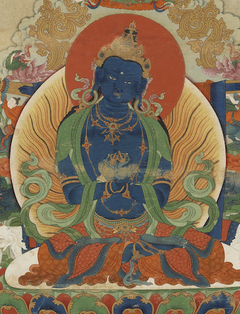Excellent Path of Definitive Meaning
The Excellent Path of Definitive Meaning
An Unmistaken Expression of the Definitive Mahāmudrā
by Jamyang Khyentse Chökyi Lodrö
Omnipresent Vajradhara, Tilopa,
Nāro, Maitrī, Marpa, Mila, Dakpo and the rest—
Countless Kagyü adepts, look on me with compassion.
What I call my own mind is this flickering awareness,
Intermittently thinking of everything under the sun.
Its apparent reality, when it is left unexamined, is what binds.
Caught up in hopes and fears, I am exhausted by existence
With all its dualistic thinking, deluded ideas and acceptance and rejection.
When, through the kindness of the guru, I do apply analysis,
I see that mind is entirely empty of origination, presence and departure.
Without basis or origin, mind itself is great emptiness.
It is the natural state of all things in saṃsāra and nirvāṇa.
It is the limitless dharmadhātu, vast and expansive.
Awareness and unawareness are what we label ‘saṃsāra’ and ‘nirvāṇa’.
With realization, we’re buddhas; in its absence, we’re ordinary beings.
In fact, neither saṃsāra nor nirvāṇa is real.
The names for this include dharmadhātu, sugata-essence,
Vajra-of-mind, and emptiness complete with all supreme aspects.
There are many names, but all refer to the same thing.
As for the stages of the path to realizing this,
They include maturing one’s being, training the mind, gathering the accumulations,
Purifying obscurations, and devotion—through the application of these key points
We can receive the guru’s blessings, and then through symbolic means,
Or without any teaching and without meditating, in an instant,
The guru and disciple merge as one within the dharmatā,
So that awareness is suddenly clear in inexpressible Mahāmudrā.
Untainted by ordinary consciousness, this is the union of clarity and emptiness.
It is experienced as perpetual, timeless, beyond the three times.
Without grasping or effort and not slipping into distraction,
We avoid the trap of mental constructs or any wish to meditate.
Sensory impressions and thoughts are self-liberating; they vanish by themselves.
From the very moment of their arising they are on the way to being liberated.
And stillness, movement and awareness are understood to be great equality.
Any thought that occurs dawns as the display of dharmakāya,
And we gain boundless qualities of knowledge, love and power.
When energy-mind and experience merge inseparably,
We have reached the limit of the path Mahāmudrā.
With fruitional Mahāmudrā, body and mind are unobstructed;
All-pervasive like space, they possess the seven aspects of union,[1]
A treasury of the oceanic qualities of the kāyas and wisdoms,
And we attain the state of the glorious and mighty Vajradhara.
This was written by Yeshe Dorje.
| Translated by Adam Pearcey, 2020 with the generous support of the Khyentse Foundation and Tertön Sogyal Trust.
Bibliography
Tibetan Sources
'jam dbyangs chos kyi blo gros. "nges don phyag rgya chen po'i rtogs pa ma 'khrul bar brjod pa nges don lam bzang" in ’jam dbyangs chos kyi blo gros kyi gsung ’bum. 12 vols. Bir: Khyentse Labrang, 2012. W1KG12986 Vol. 8: 565–566
'Jam dbyangs chos kyi blo gros. "nges don phyag rgya chen po'i rtogs pa ma 'khrul bar brjod pa nges don lam bzang" in gsung 'bum/_'jam dbyangs chos kyi blo gros/ (dbu med/). BDRC W21813. 8 vols. Gangtok: Dzongsar Khyentse Labrang, 1981–1985. Vol. 2: 469–471
Version: 1.2-20250220
-
The seven qualities of a sambhogakāya buddha are: complete enjoyment, union, great bliss, absence of a self-nature, presence of compassion, being uninterrupted and being unceasing. ↩
